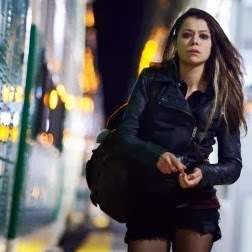ORPHAN BLACK: Orphan Black’s title isn’t the only thing that should make you think of film noir. The show presents a clear understanding of the core fundamentals of a genre best visualized by Alfred Hitchcock—the suspense thriller.
In keeping with themes and concepts native to the suspense thriller genre, what Orphan Black creates in its mythology and character development can, in many ways, be considered a contemporary example of serialized film noir, or rather, neo-noir.
In keeping with themes and concepts native to the suspense thriller genre, what Orphan Black creates in its mythology and character development can, in many ways, be considered a contemporary example of serialized film noir, or rather, neo-noir.

ORPHAN BLACK: Orphan Black’s title isn’t the only thing that should make you think of film noir. The show presents a clear understanding of the core fundamentals of a genre best visualized by Alfred Hitchcock—the suspense thriller.
In keeping with themes and concepts native to the suspense thriller genre, what Orphan Black creates in its mythology and character development can, in many ways, be considered a contemporary example of serialized film noir, or rather, neo-noir.
 |
|
| It was a dark and stormy night...well, actually, it was just dark. |
 |
| First of all, hats. You can't have noir without hats. It's a rule. Look it up. |
The suspense thriller is a genre which uses suspense—which is on one level a simple structural device, and on a second level a psychological device which directly engages the spectator by causing anxiety and setting off complex subconscious mechanisms.Essentially for Derry, the suspense thriller is a method of psychologically charged storytelling which encompasses multiple genres, from horror to crime to noir. It is designed to propel the viewer to the edge of their seat through the use of:
With Sarah Manning as our antiheroic protagonist, constant motion is no stranger. In the show's first episode, she even describes herself as: "back on the run...the usual Sarah shite storm." And, the never-ending string of problems she continues to run straight into quickly form a steady battle between good and evil, right and wrong, and self and other. However, these binaries are often blurred in Orphan Black, resulting in an interesting melding of method and genre which, together, create thrilling, compelling, and emotionally gripping storytelling.
- constant motion on the part of an often antiheroic an/or wrongfully accused protagonist
- compounding problems
- a visceral struggle typically between good and evil
And gripping it is from its very start. Because, in fact, evidence of Orphan Black's classic suspense thriller journey begins with a scene at a train station.
 |
| Murder mystery, conspiracy, and general mayhem brought to you by Beth Childs... throwing herself in front of trains since March 30, 2013. |
 |
| Let's cut to the chase old chap, how much devilment do you think we can get into between this carriage and the end of the movie? Hella. That's how much. |
 |
|
| You might say the train acts as a plot...vehicle. |
 |
| Any contrivances related to Marnie, however, must stop with the train station and money theft. Even Sarah “The Biggest Mess There Is” Manning would raise her brow at dear, psychologically tormented Marnie. |
In Japanese culture, the railway can be symbolized as the break between the furusato (home town) or the place that one originates from and that often carries strong emotional overtones, and the modern city, where adults go to study and work. The railway therefore establishes a link between the two worlds of childhood innocence and the adult world full of promise, mystery and anxiety. (source)In this vein of thought, Sarah could be observed entirely from behind a contextual window of classic noir/suspense thriller themes. She is a flawed but essentially well-meaning person—the classic noir hero(ine)—intrinsically born to run, drawn home in search of herself, and carried by an iconic vehicle of change which ultimately brings her into confrontation with herself in more ways than one.
As an homage to the noir genre, Orphan Black is intriguing and unique, especially in that, unlike the classic iterations of the genre, the protagonist is female, a rarity in the genre. And, as a suspense thriller/neo-noir piece, it is definitely successful in its implementation of those age-old storytelling techniques which seek to grab ahold of a viewer by the throat and never let go until the ride is over.
As Cosima would say: "Welcome to the trip."

Hafsah is a medium-mannered graphic designer, writer, film buff, and raging root beer enthusiast, in no particular order.
Follow Hafsah on and .


No comments :
Post a Comment